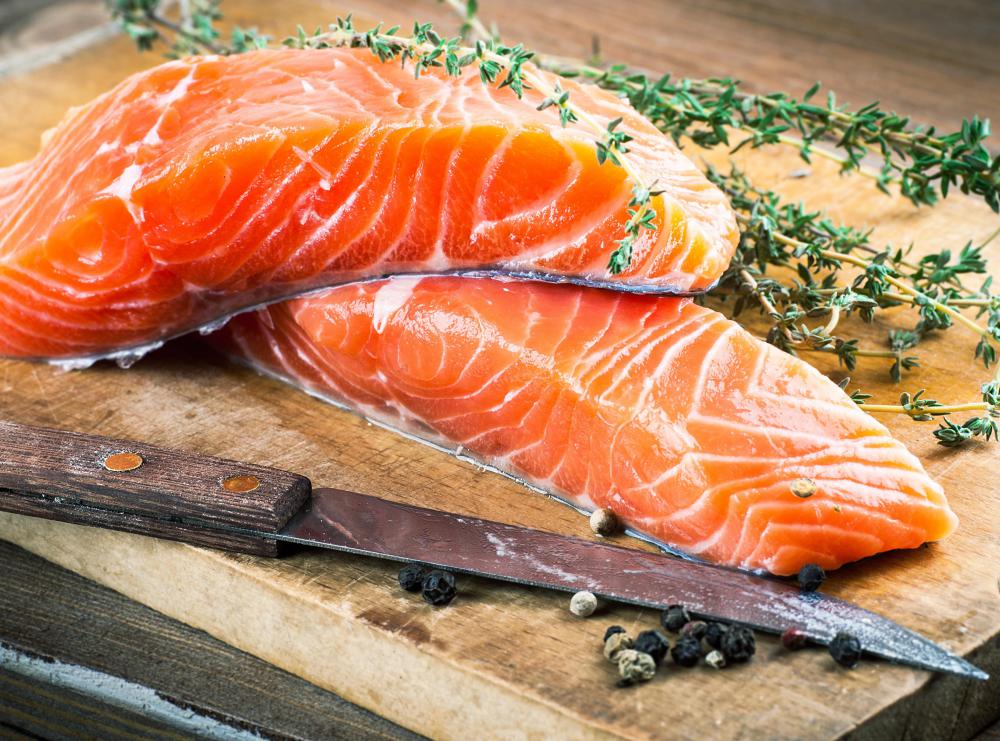At AllThingsNature, we're committed to delivering accurate, trustworthy information. Our expert-authored content is rigorously fact-checked and sourced from credible authorities. Discover how we uphold the highest standards in providing you with reliable knowledge.
What is a Sea Louse?
A sea louse is a tiny parasitic creature that attaches itself to a living host, usually a fish. There are a number of different species of sea louse, and the most problematic species infest commercial fish, both wild and farmed, such as salmon and trout. The sea louse eats the skin, blood, and mucous of the host fish.
Commercial fish farms provide the perfect breeding ground for sea lice — the plural of sea louse — because of the large numbers of host fish in a comparatively small area. This means that huge numbers of the parasite accumulate and breed rapidly, infecting large quantities of fish and continuing to multiply. Although most farmed fish are treated regularly with chemical insecticides, vast numbers of viable eggs escape the treatment as they pass beyond the farmed waters and infect wild fish. Evidence also suggests that in some areas sea lice are developing a natural resistance to available treatments. The rapidly increasing numbers of sea lice, largely due to commercial fish farms, is putting wild fish populations at serious risk.

A single female sea louse can lay up to 1,000 eggs at a time, which are released in long trailers. The eggs drift freely in the sea for several days before hatching. The newly hatched organism drifts for about 10 days before attaching to a host and beginning to feed. It is not until the sea louse matures, moving around on the host and causing huge amounts of damage, that it becomes life threatening. If left untreated, an infestation of sea lice is often fatal to the host.
These parasites are particularly dangerous to salmon or trout. It takes only a single creature to cause enough damage to kill a juvenile salmon or trout. Serious infestations cause large, open wounds or lesions on the skin and causes extensive fin damage and severe bleeding. This type of extensive damage leaves the host fish open to secondary infection and unable to regulate and sustain its temperature and balance.
If an infected wild fish returns from the sea to fresh water, the sea louse is unable to survive and it falls off the host; this allows the host fish to recover, as long as it does not pick up an infection before the wounds are healed. Although wild fish often survive if they leave the sea early, their growth rate slows; healthy salmon and trout species feed heavily in the sea and grow rapidly before returning to fresh water. A fish with a louse infestation will often return to fresh water much earlier than normal in an attempt to rid itself of the parasite. These fish miss much of the feeding time, which considerably slows their growth rate and the time it takes to reach sexual maturity. This, combined with the host fish very high mortality rate, means the sea louse has a very negative economical and environmental impact.
Frequently Asked Questions
What exactly is a sea louse?
A sea louse is a parasitic crustacean from the family Caligidae, primarily found on marine fish. They are small, with adult sea lice measuring up to 12 millimeters in length. These parasites feed on the mucus, epidermal tissue, and blood of host fish, causing damage that can lead to secondary infections or even death in severe infestations.
How do sea lice affect marine ecosystems?
Sea lice can significantly impact marine ecosystems, particularly in areas with high densities of fish farms. Infestations can spread rapidly among captive fish, leading to poor health and high mortality rates. Wild fish populations can also be affected when they swim near infested farms, disrupting the balance of the marine environment.
Can sea lice harm humans?
Sea lice pose little direct threat to humans as they do not live on or infect human hosts. However, swimmers in infested waters may experience sea lice dermatitis, a skin irritation caused by the larvae of a different organism, often mistakenly referred to as sea lice. This condition is usually self-limiting and can be treated with over-the-counter remedies.
What methods are used to control sea lice in aquaculture?
To control sea lice in aquaculture, farmers employ various strategies, including chemical treatments, biological controls like cleaner fish that eat the parasites, and environmental management practices. According to research, integrated pest management approaches that combine these methods are most effective in reducing sea lice populations while minimizing environmental impact.
Are sea lice found in all oceans?
Sea lice are predominantly found in saltwater environments and are present in most oceans where their host fish reside. They are particularly prevalent in areas with large populations of salmon and other marine fish, both wild and farmed, as these provide ample opportunity for the parasites to feed and reproduce.
How do sea lice reproduce and how fast can they spread?
Sea lice reproduce by laying eggs that hatch into free-swimming larvae. These larvae can spread rapidly, especially in conditions with high host densities, such as fish farms. A single female sea louse can produce hundreds of eggs, which can mature into reproducing adults within a few weeks, leading to exponential growth if left unchecked.
AS FEATURED ON:
AS FEATURED ON:











Discuss this Article
Post your comments